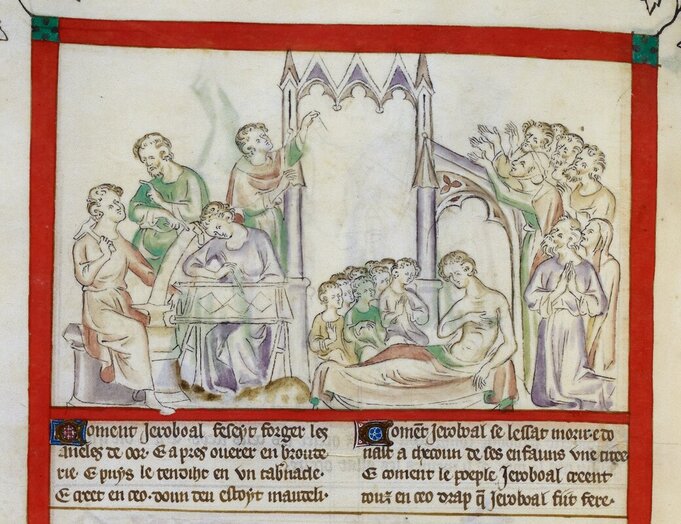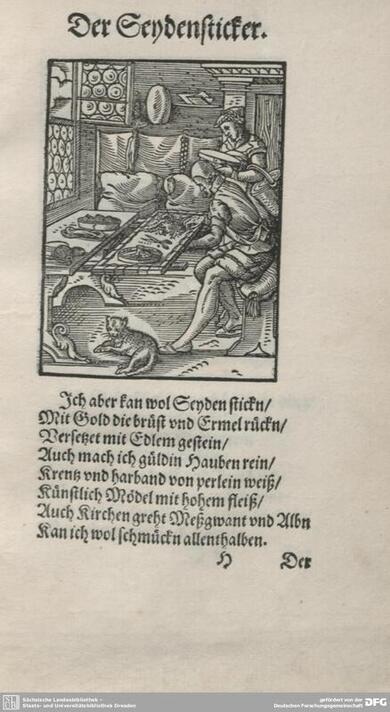|
Some of you will know that I don't have a tv. Instead, I watch interesting documentaries (and highly necessary series like 'The Great British Bake Off`) directly on my laptop. One of my favourite channels is 'Arte' a French-German co-production. During this weekend's browse, I found a five-part series on the artisan production of fabric in Asia. Very beautiful and informative! The one on India zooms in on an embroidery atelier in Mumbai directed by the Italian professional embroiderer Maximiliano Modesti. He employs 600 embroiderers. All male, 98% muslim. Women do embroider, but not in a professional setting. This made me wonder how things were done in the 15th and 16th centuries in the Low Countries? After all, my favourite style of goldwork embroidery that I use as a basis for my artwork was made during this time. Would master embroiderer Jacob van Malborch have employed me if I had also lived in Utrecht in the first quarter of the 16th century? Someone who has done extensive research during the '80s and '90s into the organisation of professional embroiderers during the late Middle Ages and the Early Modern Times in the Low Countries is Prof. Dr. Saskia de Bodt. She extended and corrected the earlier attempts of Dr. Beatrice Jansen executed some 40 years earlier. In more recent years, art historian Dr. Marike van Roon researched the Dutch embroidery ateliers active between 1830-1965 extensively. As far as I know, more recent research into the role and organisation of medieval embroiderers is not available for the Low Countries. Note: It seems that the above-named scholars started their careers researching embroidery, but soon gave up in favour of more 'real' art history like 19th-century paintings or ceramics. Even in research, embroidery seems to have an image problem ... After going through many written sources such as the financial records of churches and towns, baptism records, marriage registers and death records from the 15th- 17th century located in the Northern Netherlands, Saskia de Bodt concludes that the professional embroiderer was a man. Only the men, like Jacob van Malborch and many others, are named. If a woman does show up in the records it is not under her own name but only as huysvrou van (housewife of) followed by the name of the master embroiderer. However, women were not explicitly excluded from the guild either. On the contrary. When the embroiderers of Utrecht formed their own guild in 1610, the guild ordinance speaks of meestersschen (female masters). The guild of embroiderers in Leeuwarden probably only consisted of men as the ordinance only mentions meesters and inwoonderssonen (masters and sons of poorters). But in Dordrecht, the embroiderers split from the St. Luke guild in 1487 as a result of a feud between the women ...
So would master Jacob van Malborch have taken me on as an apprentice? Possibly. Would someone have written down my name? Certainly not in the Low Countries. Female embroiderers are known from the written sources in other European countries. So I could have learned the ropes with master Jacob and then, after fretting over not making it into the written record, emigrate to Cologne or over the seas to England. But that's stuff for a further blog post. Sources: Bodt, S.F.M. de, 1991. Borduurwerkers aan het werk voor de Utrechtse kapittel- en parochiekerken 1500-1580, Oud Holland 105, pp. 1-31. Bodt, S.F.M. de, 1987. De professionele borduurwerkers. In: S.F.M. de Bodt, M.L. Caron et al, Schilderen met gouddraad en zijde, Museum Catharijneconvent Utrecht. Jansen, B., 1948. Laat Gotisch borduurwerk in Nederland, Boucher.
6 Comments
Christine Brunner
7/10/2019 16:36:53
Interesting read. Thank you.
Reply
7/10/2019 18:41:15
As a former archaeologist I am only too aware of the limitations of our sources, Rachel. That's why I found the link with India and the thousands of professional male embroiderers so fascinating. The records for the Low Countries seem pretty rich and the fact that women are not named in conjunction with the large embroidery jobs offered by the church or the town's magistrate at least shows that they very likely had not the same standing as the male embroiderers.
Reply
sharon
8/10/2019 05:19:15
how times have changed. to have men stitch, where i live, is rarer than hens teeth. i wish more men would stitch. to be so absorbed in the zen of stitching, might make for more peaceful lives.
Reply
8/10/2019 09:17:41
I couldn't agree more Sharon! My grandfather stitched and I think I've inherited his genes :).
Reply
Your comment will be posted after it is approved.
Leave a Reply. |
Want to keep up with my embroidery adventures? Sign up for my weekly Newsletter to get notified of new blogs, courses and workshops!
Liked my blog? Please consider making a donation or becoming a Patron so that I can keep up the good work and my blog ad-free!
Categories
All
Archives
July 2024
|
Contact: info(at)jessicagrimm.com
Copyright Dr Jessica M. Grimm - Mandlweg 3, 82488 Ettal, Deutschland - +49(0)8822 2782219 (Monday, Tuesday, Friday & Saturday 9.00-17.00 CET)
Impressum - Legal Notice - Datenschutzerklärung - Privacy Policy - Webshop ABG - Widerrufsrecht - Disclaimer
Copyright Dr Jessica M. Grimm - Mandlweg 3, 82488 Ettal, Deutschland - +49(0)8822 2782219 (Monday, Tuesday, Friday & Saturday 9.00-17.00 CET)
Impressum - Legal Notice - Datenschutzerklärung - Privacy Policy - Webshop ABG - Widerrufsrecht - Disclaimer








 RSS Feed
RSS Feed